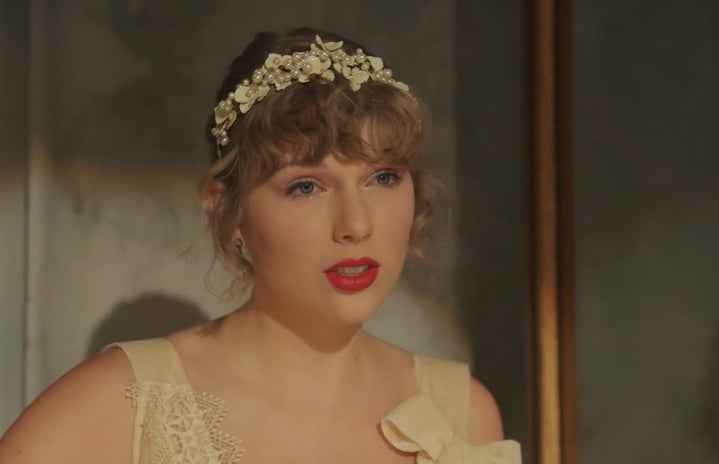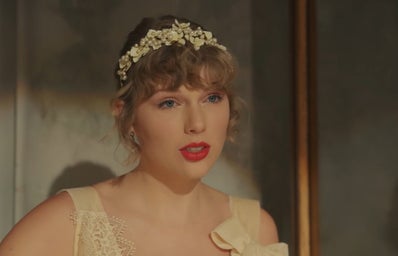Taylor Swift already surprised her fans once this year with the sudden release of her eighth studio album, Folklore, this past July. Dropped just eleven months after its predecessor, this was out of character for Swift, who has previously spaced out the release of new records by at least two years. But as she shared in an interview, Taylor just “can’t stop writing music” over quarantine, and so the artist bestowed another gift on us this past week: her ninth album, Evermore. It’s a sister album to Folklore, and throughout the short time it has been available on streaming platforms, it has skyrocketed on the charts, receiving rave reviews from both critics and fans. As someone who has listened to Swift’s music since 2009, I was ecstatic to have the opportunity to share my own thoughts on the newest addition to her discography.
To provide some background about myself as a Taylor Swift listener: I grew up obsessed with Taylor’s music. I have some of the most vivid memories of jamming out to all of Speak Now on my iPod Touch, a Fearless CD forever situated in our car’s music player, ready to be turned to maximum volume anytime my family traveled anywhere at all. Red and 1989 are timeless gems—”All Too Well,” “All You Had to Do Was Stay,” and “Wildest Dreams” are among some of my all-time favorite Swift songs—and, in my opinion, Reputation is undoubtedly Taylor’s best album to date, with its risky motifs of revenge and desire perfectly infused in every melody.
After months upon months of being in love with all of Reputation—it’s a no-skip album, where “Dress,” “Getaway Car,” and “I Did Something Bad” are the absolute best of the best—I was disappointed by her 2019 release of Lover, to say the least. A singular scan through the whole album made me feel like I had overdosed on artificial sugar sweetener and cheesy rom-coms, and naturally, I felt myself grow distant from Taylor’s more recent work. It wasn’t until this fall, several weeks after the July 2020 release of Folklore, that a few online snippets of her newest songs piqued my interest and prompted me to take a look at the album as a whole. All it took was one listen to lead single “cardigan” for me to realize that Lover was a blip in an otherwise outstanding discography, not a record indicative of a career decline.
So here I am, a Taylor Swift fan once again. I would have been perfectly comfortable sifting through the emotional depths of Folklore for a while longer, but I obviously welcome this surprise of an album with wide arms. Below are my thoughts about Evermore, entirely raw and unfiltered, rooted solely in my first few listens to each of the songs:
- “willow”
-
Seeing that “willow” is Evermore’s opening track and the lead single off of the album, I had high expectations for it. But in listening to it, I was somewhat disappointed, as the only thing “willow” seems to have going for itself is its catchy—and albeit, repetitive—chorus. Considering this is most likely the first song many listeners will associate with Evermore, it should be concerning that I wasn’t infatuated with it, but this isn’t the first time that Swift has opened her album with a lackluster piece; Red kicked off with the relatively forgettable “State of Grace,” and 1989’s intro “Welcome to New York,” while relatively popular, was not my cup of tea.
The individual lyrics of “willow” are witty, though they don’t seem to flow together in much of a cohesive story, and in all, the track feels as though it’s lacking something for me personally. Nonetheless, its catchiness does make for a memorable tune, and because of this aspect, I can see it making a splash in mainstream pop music, becoming one of those overplayed staples that you can hear on any radio station at least twice a day from now until the end of winter.
- “champagne problems”
-
With piano chords reminiscent of something between a bonus-edition Red track and a headliner straight from Fearless, “champagne problems” is equally as nostalgic as it is charming. I can’t quite put my finger on a specific song that it reminds me of, but something about the introductory chord progression makes me feel like we’re about to dive into a melody that I’ve known the lyrics to since I was eight years old. I love the familiarity of it.
Beyond this, “champagne problems” discusses the aftermath of a rejected marriage proposal, and while it’s unclear whether this story is about Taylor and her current boyfriend, Joe, or if the situation at hand is entirely fictitious, the words are harrowing, each line like an emotional punch to the gut. I love the warm imagery here, too; I am a sucker for highly specific descriptions that evoke a deep sense of intimacy, and “champagne problems” has no shortage of this, with lines like “your Midas touch on the Chevy door” and “she’ll patch up the tapestry that I shred.” The storytelling aspect of this piece as a whole is chiling, unflinchingly authentic for only being two songs into the record.
“champagne problems” makes itself into my top five on the album for sure, perhaps even landing in second or third place overall. This track is cozy, eloquent, and lyrically profound, three key components for the success of any Swift ballad.
- “gold rush”
-
During the live premiere of the “willow” music video, Swift described “gold rush” as a song that “takes place inside a single daydream where you get lost in thought for a minute and then snap out of it.” The track does exactly that, capturing the feeling of irresistible, instant attraction with ease, as lyrics like “eyes like sinking ships on waters so inviting I almost jump in” demonstrate.
The production here is so right, where sparkly sounds and a building melody helps to put it ahead of “Gorgeous,” one of Swift’s 2017 singles off of Reputation with the same giddy descriptions but less musicality and far too many synth effects. I envision this track being a bit slow to take off, but once it starts getting the recognition it deserves, it will rise to its deserving place as one of the best songs off Evermore.
- “’tis the damn season”
-
“‘tis the damn season” is Swift’s annual ode to wintertime, Evermore’s opportunity to revel in motifs of cold weather and snowy scenery. The song details a hometown hook-up between two presumably college-aged young adults who are home for the holidays, as explained by the tune’s catchy chorus. Swift sings that “I’m staying at my parents’ house, and the road not taken looks really good right now, and it always leads to you and my hometown” over a calm, grooving rhythm.
The song is extraordinarily nostalgic, a seemingly common theme throughout many of the tracks on Evermore. This feeling of conversancy is bolstered by Swift’s description of a parked car between “the Methodist and the school that used to be ours.” In all, this song is fun and relatable while still flaunting lyrical prowess. Swift can hardly go wrong. - “tolerate it”
-
Past track fives on Swift’s albums have a reputation for being heart-wrenching, extravagantly emotional pieces, and “tolerate it” is no exception to the rule. This track follows the experiences of a woman who seems to be devoting endless love and energy towards her partner, only to be met with mere acceptance and nothing more. It’s a circumstance that I personally can’t relate to, but it makes for an absolutely stunning song nonetheless.
- “no body, no crime” feat. Haim
-
Every album has that song that you listen to and fall in love with almost instantly, the track that brings the entire work together. “no body, no crime” occupies that role for Evermore, where the quiet whine of a harmonica in the background and the very “Before He Cheats” by Carrie Underwood-esque vibe of it all makes the listener want to hit the repeat button over and over and over again.
Swift is completely in her element here, with a savvy mix of the country sounds native to her first three albums, the mystery and impulsivity of Reputation, and enough of Folklore’s woodsy feel to make this track fit in seamlessly with the rest of Evermore. It also features that same pulsing storytelling element that is reminiscent of many of her past hits, like “Better than Revenge.”
If there’s one song you listen to on Evermore, it has to be “no body, no crime.”
- “happiness”
-
After a slew of enjoyable tracks, “happiness” swoops in and feels like a letdown. There’s nothing inherently wrong with “happiness”; it’s just blah, mundane, forgettable. This seems to be the primary issue with Evermore as a whole, that some tracks have the ability to really stand out and stick in the listener’s head for hours, while others are purely background music, don’t bring much more to the table than some intermediate lyrical acrobatics that fail to make a splash amongst Swift’s far more impressive tracks. I actually had to relisten to this song several times just to share my thoughts about it because I couldn’t really remember much of its lyrics or melody.
“happiness” is an easy skip, an unexciting attempt at a climatic ballad.
- “dorothea”
-
At this point during my first listen to Evermore, I’m starting to wonder if the album has hit a slump, because “dorothea” is just as boring and plain as its predecessor. The vocals, while not bad, are almost whiny and annoying in spots. And as far as the stylistic elements, “dorothea” seems to have occasional hints of country sound intertwined throughout it, which would be welcomed if it weren’t for the overall dullness of the piece. No southern twang can save this one.
Perhaps the only truly interesting thing about “dorothea” is that its cryptic lyrics have sparked rumors that perhaps Swift’s former friendship with Selena Gomez is the track’s subject. Regardless of whether that’s true, I anticipate that “dorothea” will remain a rather forgettable song throughout the record as a whole.
- “coney island” feat. The National
-
“coney island” is confirmation that, yes, Evermore has in fact fallen into a slump. Honestly, I think this track would be far better off as a solo for Swift; something about The National’s abrupt feature feels awkward and clunky. And while the track’s concept of a vibrant, summer-y amusement park contrasted with romantic longing is creative and intriguing, its execution is weak. I think randomly inserting the word “centerfold” in the chorus is evidence enough that this song is a miss. It’s a shame, honestly, because I truly like its concept.
- “ivy”
-
Sweet, simple, and delicate, “ivy” manages to regain some points in this otherwise weak middle portion of the album. Somehow, Swift manages to make a song about infidelity sound like a cutesy pop tune accompanied by the innocent strum of a banjo. It’s a nice fit.
- “cowboy like me”
-
With its gentle groove, “cowboy like me” becomes something of a comfort song, a perfect piece to accompany any everyday activity. Here, it feels as though Swift has returned to her country origins once again, where the track could most certainly pass as Fearless and Folklore’s love child. “cowboy like me” is Evermore’s ideal hidden gem, sandwiched between two solid tracks that, if you’re not paying enough attention, can cause you to mistakenly miss the best part.
- “long story short”
-
Who decided to make “willow” the lead single off of Evermore? Because after listening to “long story short,” I’m convinced that the album’s twelfth track would have been a far better fit.
“long story short” is triumphant and lively, an enthusiastic return to Swift’s upbeat melodies with definite chart-topping potential. It’s the kind of song that gets stuck in your head for hours and makes you want to sing it at the top of your lungs with a hairbrush in hand. Sure, the track doesn’t feature the same lyrical complexity as standouts like “champagne problems” and “tolerate it,” but it’s not overly simplistic, either. To make a long story short, “long story short” is pure fun.
- “marjorie”
-
An eloquent and moving tribute to Swift’s late grandmother, “marjorie” is a poignant story of grief that flawlessly rounds out the more mellow second-half of the record. Lyrically, it is beautiful and deeply artistic. But from a listener’s perspective, I can’t see myself wanting to turn on this song while casually doing homework or getting ready in the morning. In fact, unless I’m in a particularly somber mood, I can’t visualize myself playing “marjorie” for really any reason at all.
In writing this song, I think Swift understands why such a paradox exists; similar to past tracks from her discography like “Never Grow Up”, such songs are not intended to be radio hits or to even be included on a playlist of any kind. Tracks like “marjorie” instead are something of trophies within Swift’s discography, evidence of the artistry and emotionality her work possesses.
On paper, “marjorie” is one of Evermore’s best, as its moving lyrics demonstrate. But in practice? “marjorie” is just too melancholic for my taste.
- “closure”
-
I really want to like this song, but the production is all wrong here. As the shortest song on the album, it falls flat on its face, with clanky electronic sounds clashing against sweet and nurturing lyrics. Swift took a risk here, and while I would normally welcome such a change of pace, especially for an artist who historically has excelled in experimenting with new genres and styles, this track simply just doesn’t work.
- “evermore” feat. Bon Iver
-
Ah, the finale. Evermore’s namesake track isn’t quite as memorable as it perhaps should be for a closer, but it is sufficient nonetheless. At over five minutes in length, the track wears out its welcome through a painfully slow introduction that is suddenly met with an acceleration in tempo and Bon Iver’s falsetto vocals. It has parts where I want to turn the song off, while at other times, I genuinely enjoy my listening experience and anxiously await the next line. “evermore” truly is a mixed bag, bound to charm some fans, bore others, and leave many oscillating between these two responses.
The bottom line: Is Evermore a return to Taylor’s country roots, or is it the newest progression in her journey to explore all genres, a mere extension of the arena of alternative music that Folklore first ventured into? I’d argue that it’s both, a juxtaposition of far too many elements to simply place a singular label on.
In its entirety, Evermore has some very strong highs and a handful of weak lows, but the album as a collective unit is cohesive and functions well. While this isn’t a record that I would consider to be skip-free, it is one that is comfortable to listen to from front-to-back with the occasional press of the “next” button. In comparison to her other albums, I think that Evermore falls somewhere in the middle of the pack in her discography as a whole, where it beats out Lover, Taylor Swift, and Fearless, but doesn’t quite measure up to Folklore, Speak Now, Red, 1989, and Reputation.
Oh, and if you’re into fan theories, we might be having this conversation about another Taylor album again in the near future. Word on the Swiftie street is that an additional sister album is set to join the Folklore family soon, but we’ll see what comes of that. After all, with Taylor Swift and the myriad Easter eggs and mysterious hints she sprinkles throughout every trace of her work, it’s hard to tell what exactly we’re in store for next. Nevertheless, judging by her success on Evermore, I’d venture to guess she has something equally as savvy coming in the future.


